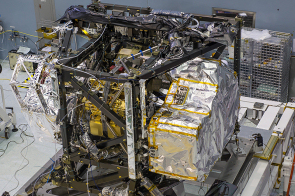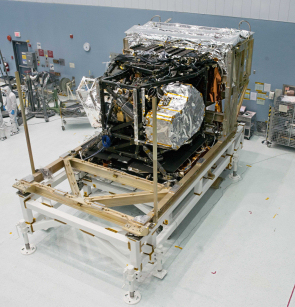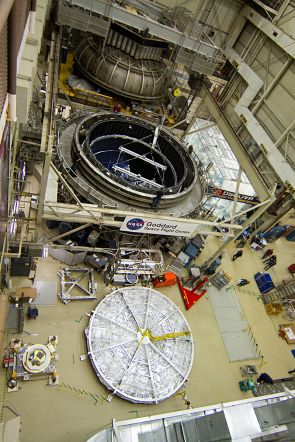#07: Summer 2014 - first combined test of all four instruments
24 February 2015
A major milestone was reached for the James Webb Space Telescope (JWST) in the summer of 2014 when all four instruments, installed on the Integrated Science Instrument Module, completed cryogenic testing at NASA's Goddard Space Flight Center (GSFC).
 |
| Fully integrated ISIM, with NIRSpec and NIRCAM instruments. Credit: NASA/Chris Gunn |
The Integrated Science Instrument Module (ISIM) supports the four science instruments (NIRSpec, MIRI, NIRCam, and FGS/NIRISS), their electronics and harnesses. With NIRSpec having joined MIRI, FGS/NIRISS and NIRCam in the ISIM payload module during March 2014, the second ISIM-level cryogenic test campaign could begin. (The first such campaign, to test the performance of the instruments at temperatures similar to those they will experience when in space, had taken place between August and November 2013 with only two of the instruments (MIRI and FGS/NIRISS) in place.)
Early in June 2014, the ISIM was installed in the large Space Environment Simulator (SES) test chamber at GSFC and on 16 June the door of the chamber was closed and the pump-down started; within 36 hours all the air had been evacuated. It then took a full week to check that ISIM, the four instruments and all the test equipment were still working correctly under ambient temperature conditions and that the cool-down could start.
Once the cool-down phase had begun, almost three weeks were needed for ISIM and the instruments to reach the extremely low temperature they will experience in space. For ISIM and the three near-infrared instruments (NIRSpec, FGS/NIRISS and NIRCam), this means approximately -233 °C (40.15 K) while MIRI was cooled down even further to -266 °C (7.15 K) thanks to a dedicated cooling system called the MIRI cryo-cooler, which was developed by NASA's Jet Propulsion Laboratory.

Above: JWST payload module (ISIM).
Right: Space Environment Simulator. |
 |
Once ISIM and the instruments had reached their operating temperatures, the team of scientists and engineers began an extensive series of checks to ensure not only that the instruments were performing in accordance with their specification and had been correctly aligned in ISIM, but that all four could work together satisfactorily, without interference. This was the first time that the technical teams could satisfy themselves that this important operational constraint could be satisfied as the previous ISIM-level cryogenic test had not had all the instruments present. Testing at operating temperatures continued until 23 September 2014.
The ISIM and instruments were then gradually brought back to ambient environmental conditions, with warm-up being completed during the week of 4 October. With the opening of the SES chamber door on 10 October this second ISIM-level cryogenic test campaign came to an end. Analysis of the data collected during this campaign indicate that all the primary goals of this campaign were reached. The work of the European teams was naturally focused on NIRSpec and MIRI and they were very pleased that both instruments performed very well during this campaign, confirming their good health and alignment.
This long and intense '24/7' campaign, lasting a total of 116 days, was not only a success for the hardware which performed magnificently but also for all the members of the teams, coming from the USA, Canada and Europe, whose dedication and ability to work together ensured that this very long and complex campaign was a success.
About JWST
The James Webb Space Telescope (JWST) will be a general-purpose observatory with a 6.5-metre telescope optimised for infrared observations and a suite of four astronomical instruments capable of addressing many of the outstanding issues in astronomy. The primary aim is to examine the first light in the Universe – those objects which formed shortly after the Big Bang. Further aims include: looking at how galaxies form; the birth of stars; and the search for protoplanetary systems and the origin of life, including the study of exoplanets. JWST is a joint project of NASA, ESA and the Canadian Space Agency. It is scheduled for launch in 2018 on an Ariane 5 and will operate approximately 1.5 million kilometres from the Earth in an orbit around the second Lagrange point of the Sun-Earth system, L2.
About MIRI
The Mid-Infrared Instrument (MIRI) is one of four instruments on JWST. MIRI will provide direct imaging, medium- and low-resolution spectroscopy, and coronagraphic imaging. It is expected to make important contributions in all of the primary science aims of JWST. MIRI was developed as a partnership between Europe and the USA – the main partners are a consortium of nationally funded European institutes (the MIRI European Consortium), the Jet Propulsion Laboratory (JPL), ESA, and NASA's Goddard Space Flight Center.
About NIRSpec
The Near InfraRed Spectrograph (NIRSpec) is one of four instruments on JWST. NIRSpec is a multi-object spectrograph capable of observing more than 100 astronomical objects simultaneously. It will support JWST's four main science themes by providing low, medium and high-resolution spectroscopic observations.
NIRSpec was built by European industry to ESA's specifications and managed by the ESA JWST Project at ESTEC, the Netherlands. The prime contractor is Airbus Defence and Space GmbH (formerly EADS Astrium GmbH) in Ottobrunn, Germany. The NIRSpec detector and microshutter array (MSA) subsystems are provided by NASA's Goddard Space Flight Center.




